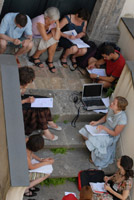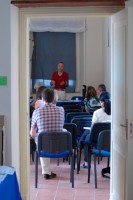How to design a scenario workshop on local management of ocean rises and flooding for local actors?
Contact:
Ida-Elisabeth Andersen, The Danish Board of Technology, ia@tekno.dk
This case study guides participants step by step through the design of a scenario workshop on local management of ocean rise and flooding for local actors. Background for the development of this case is a project from 2004 at the national Technology Assessment institute, the Danish Board of Technology about the challenges the rise of sea level will cause in coastal areas.
Short description of the case

In this case study the participants will play the role of the project manager and write/draft a project description for a scenario workshop, which addresses the consequences of future ocean rises and flooding that are caused by change in climate. They are introduced to the context of the case and to the scenario workshop method. During the day the participants are going to relate to the tasks and questions, which the project manager has to consider, when planning and organising a project involving research based knowledge - as well as knowledge and experience of local actors. Phases and steps of the day are:
- Introduction
- Framing and choice of method
- Use of knowledge: what kind of knowledge is needed in this project?
- Preparation of scenarios: ideas and keywords
- Detailed planning of the workshop itself.
Training objectives
- Which phases and steps are involved in planning and organising a project with public participation
- The conception of method and framing in this context
- The conception of dialogue, knowledge, actors etc.
- How to manage project outcomes and communication
- (something about) How to think and work as a project manager in a TA institution addressing national and local authorities

This case is specifically designed for people, who want to get advice and learn more about way of thinking and practical steps in the project manager job. Can be relevant both to people in a national or local TA institution like the DBT, to project managers in consultancy firms, and to persons who have a general interest in citizens participation in science and technology.
Training method
Participants will be divided in working groups with 5-6 persons in each group. The composition of these groups will not change during the day, but there will also be arranged plenary sessions from time to time. The organisers of the case workshop will assist the groups in working with the tasks and descriptions of assignments will be distributed to participants.
The case requires 6½-7½ hours including one hour for lunch break.
Previous knowledge required:
If the work with the case shall be efficient; participants have to accept, that this is not about designing a project on why the ocean is rising? – but on HOW to manage and adapt to consequences of ocean rise as local actors, and to foresee and discuss, what are the possible consequences.
When preparing this case study participants should especially consider the following case study resources:
- ID card on Ocean Rise
- The CIPAST poster on scenario workshop
- B1 guidelines project description
- D2 Ocean Rise documents
- E1 Workshop methods
Furthermore participants can read the materials provided for this case study to be found at the CIPAST website. (www.cipast.org).
Guideline on how to work with the case study
1. Read the introduction ‘Before the Ocean rises’ [120.4 kb, pdf] of the case study Ocean Rise
2. Read: the ID card Ocean Rise [75.5 kb, pdf]
A. INTRODUCTION
3. Read A1: the CIPAST poster on Scenario Workshop [127 kb, pdf]
4. Read A2: the PPP Introduction of the programme and the purpose of the workshop [79.5 kb, ppt] (don’t forget to read the notes!)
5. Read A3: the presentation folder of the Danish Board of Technology on the website www.tekno.dk (http://www.tekno.dk/subpage.php3?page=statisk/uk_presentationfolder.php3&toppic=aboutus&language=uk) or here [252.4 kb, pdf]
Split into groups of 5-6 persons.
B. FRAMING
Framing is about the angle you define the problem. An example when dealing with Ocean Rise: if you look for explanations for ocean rise, your project will result in various explanations. But when you frame the problem differently, and see the problem of ocean rise as a fact, you search for options for action. What can be done? Who can do it? Framing is necessary: time and resources are always limited!
6. Read B1: General guidelines for project descriptions for the DBT [181.8 kb, pdf]
7. Answer the questions of B2: Template project description [98.8 kb, pdf]
8. Present your results in plenary and discuss them. Check your answers with B3: possible answers in project description. [122.6 kb, pdf]
Split into the same groups again.
C. WHAT KIND OF KNOWLEDGE?
One of the most important aspects of making technology assessments is to include the right kind of knowledge in your project. You are going to focus on the section in the project description concerning “project organisation”.
9. Read C1: the PPP about the different kinds of knowledge [26.5 kb, ppt]
10. Read C2: the PPP about the scientific knowledge required for a scenario workshop on ocean rise [2.7 mb, ppt], by Walther Brüsch, from the Geological Survey of Denmark and Greenland. He was part of the expert, background group for the scenario workshops on ocean rise in Denmark.
You have now heard some perspectives on the inclusion of different kinds of knowledge in different ways, when making a scenario workshop. You now have the task of more concretely identifying the right profiles to participate in the background group and the actual workshop.
11. Look at C3: the Map of Næstved [597.7 kb, pdf] and explanation [89.5 kb, pdf]
12. Answer the following questions:
Who should be invited to form the background group?
(select 5-8 profiles)
Who should be invited to participate in the scenario workshop?
(select around 20 profiles)
You should write your answers directly into B2 “project description template”. Please feel free also to make corrections to the work you have already made in the other sections of the project description.
13. Check your answers with C4: Persons in background group and invitees to participate in the scenario workshop [81.6 kb, pdf].
After this you can identify the kind of knowledge required to make a scenario workshop on ocean rise.
D. PREPARATION OF SCENARIOS
The method you learn about today is called ”scenario workshop”. But maybe you have already noticed that the meaning of ”scenario” is far from the usual implication of long, technical and detailed descriptions of future possibilities. The term is used in a different way.
14. Read D1: Presentation on the preparation of scenarios [5.8 mb, pdf]
15. Read D2: Ocean Rise scenarios [314 kb, pdf]
16. Answer the following questions:
1. How are the technical solutions presented in the different scenarios going to affect the various stakeholders present at the workshop?
2. What kind of conflicts could this result in?
17. Check your answers with D3: Possible problems and conflicts [88.4 kb, pdf]
E. DESIGN PROGRAMME OF A SCENARIO WORKSHOP
18. Read E1: the document on Workshop Methods [291.7 kb, pdf]
After this methodological introduction you will be able to make a detailed programme for the actual workshop.
The dialogue in the scenario workshop is very important. You have to think about the following questions beforehand:
- What is the aim of the dialogue?
- How to design the dialogue to match the aim in the scenario workshop?
Also the programme for a scenario workshop has to be elaborated upon:
- The practical way to structure a program for a workshop on the topic Ocean Rise
- Planning time and method in ”real time”
- How to deal with knowledge from different participants?
- How to involve the participants?
19. Discuss these questions together.
All building blocks for a scenario workshop are ready to be put in the right order.
20. Plan the three phases of a scenario workshop: critic, visions, local action plan. Every phase produces new knowledge. Deal also with this progressive way the information is released and obtained during the workshop. This will result in the programme of your scenario workshop in “real time”.
The idea of this exercise is to give you a hands-on experience of the method for engaging the participants in the right way and ensuring a constructive outcome of the process. You will experience the difficulties of designing it properly by trying to design it yourself.
21. Present your programme design in plenary, and discuss it together. Check your answers with E2: design a programme.
22. Read the outcome of the Ocean Rise scenario workshop (0-2 The Project New Climate New Life)
F: PERSPECTIVE FOR THE FUTURE
23: Plenary discussion on climate change, ocean rise and perspectives for the future. Are there other possible locations for a workshop on Ocean Rise?
G: EVALUATION
24: Please fill in G1: the handout participants impressions: positive and negative about this case workshop – and about the scenario workshop method [65.2 kb, pdf].
H: Schedule (based on Procida workshop) :
| Start | End | Activity |
|---|---|---|
| 9:30 | 10.00 | Introductory Powerpoint presentation of the programme and purpose of the workshop (A1-A3) |
| 10.00 | Split into groups | |
| 10.00 | 11.00 | Framing: General guidelines for project descriptions (B1) and group work (B2) |
| 11.00 | 11.30 | Break |
| 11.30 | 12.00 | Plenary framing session: Group presentations and plenary discussion (B3) |
| 12.00 | Split into groups again | |
| 12.00 | 13.00 | What kind of knowledge? Two presentations (C1&C2) and group work: selection of participants and background group (C3&C4) |
| 13.00 | 14.00 | Lunch |
| 14.00 | 15.00 | Preparation of scenarios: Two presentations (D1&D2) and group work on making scenarios (D3) |
| 15.00 | 16.00 | Design: presentation (E1) and group work on the detailed planning of the scenario workshop (E2) |
| 16.00 | 16.30 | Plenary session: group presentations on the scenarios and discussion |
| 16.30 | 17.00 | Perspective for the future: plenary discussion and evaluation (F1) |


